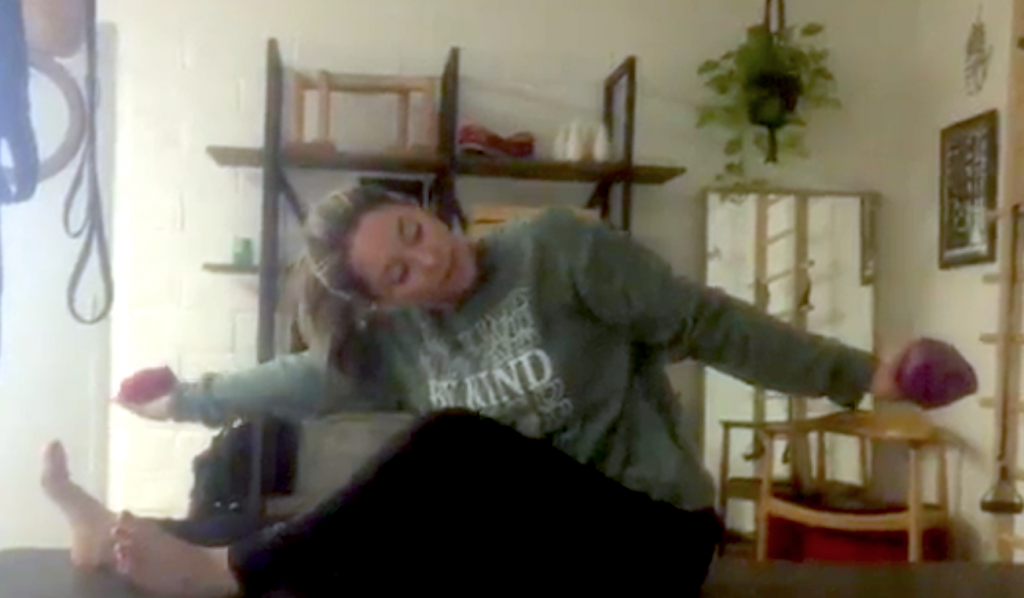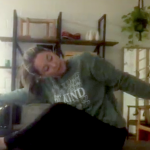Issue #262 – Wednesday, April 17, 2019
Pilates Imperfect – To Dance Between Form and Feeling
(AKA – a love letter to vulnerability and potential)
By Chantill Lopez
In this dance, we’re going to invite form to follow rather than lead.Good form is important and often critical for the health of a system. It is important to establish a foundational understanding of movement combined with sound mechanics. This is what we do when we train people. We create a clear container for understanding how the body might move better, with greater ease and efficiency.
And yet that’s only the beginning. If we stop there…
Form can drive us toward a rigid expression of movement, limit our movement options, decrease variability and therefore malleability. Sometimes it’s necessary to step back and question the system to discover what else there is beyond well-practiced form — which can be BOTH beneficial and destructive, fostering BOTH positive and negative compensation patterns.
Pilates Imperfect is an opportunity to embrace the wiggles and wobbles, the misdirection, and the asymmetry – to invite the discovery of what else might be possible in the body when form is no longer the priority.
The process looks like this:
Teach form (teacher gives to student) → practice form to develop conscious competence (student gains confidence, awareness, and trust in their body) → relinquish form to uncover new information, insight, and strategies not previously available (student becomes own teacher) → Repeat.
We can talk about this as the dance between training and facilitating.
James introduced me to these two concepts while we were preparing to shoot our Fusion Pilates EDU online workshop…wait for it…called Pilates Imperfect (set to release this spring).
When I’m teaching, I often think about it as the dance between form and feeling.
So how do we appropriately and successfully nudge our students from form to feeling within the Pilates repertoire? With a little thing called integrative movement. Let’s get curious: What is integrative movement and why might we care?
Here’s where vulnerability on your part, and on the part of your students, is unequivocally beneficial.
Moving beyond form into the field of feeling can be a tricky place to navigate especially if you haven’t been taught how to do it. In a way, EVERYTHING we do in Pilates is integrative if taught from the perspective of whole-body movement and development, putting a premium on all of the moments when we stop breaking things down into a million little pieces and start letting the body move as a whole.

Integrative movement is not a THING per se, it’s an idea, an intention, and a purposeful way of moving. Lots of modalities and practices incorporate elements of integrative movement. Here’s how I define it:
Tenets of integrative movement:
A priority on:
Integration over isolation
Wholeness over separateness
Qualitative over quantitative
Rooted in a three-part movement framework:
Preparatory movement
Principal movement
Counter movement
Inter-relational movement through all tissues
Integration of sense organs and extremities
Eyes (seeing), ears/mouth (hearing + making sound), touch (heat, pressure)
Fingers, palms, wrists
Toes, arches, ankles
An emphasis on:
Transitioning roles of stability and mobility
Variability in breathing strategies
Spontaneity and variation in movement choices
Primes the whole-person for movement via
Nervous system and emotional regulation through the body
Vagal toning
Creating supportive environment and context
In part two of this article, I’ll be introducing IMF (Integrative Movement Facilitation) which IS a thing that gives you a distinct framework to teach from these and other principles.
Let’s get real: How do you start moving from form to feeling via integrative movement?
What to do:
Take something your student knows well, like footwork, and change the context to invite more exploration. Your job is to give them some simple instruction as to what will be the same and what will be different and then get them started. As they move, guide them to explore and take chances.
My favorite example uses a medium, slightly soft Franklin ball (the smooth orange ones work well) or my new favorite prop, the Good Medicine Ball by Deep Breath Designs — heated — and placed on the sacrum. Foot position works best in parallel on the toes.
Start with an inhale to arch the low back slightly — anterior pelvic tilt — to push out. Exhale to curl the low back — posterior tilt — to pull in. Cue the breath, then the arch or curl, then finally the pull or push. Go for several rounds encouraging the student to find ease in their movement.
Then turn everything around. Exhale to curl and push out. Inhale to arch and pull in.
There are infinite options. Play with moving into rotation and trying different combinations. It’s likely your student will show you where to go.
Tips:
Be explicit in the set up — don’t over cue what the student SHOULD FEEL — and encourage your student to determine the following things for themselves:
What feels best in terms of their ROM
What feels best in terms of where to effort and initiate
Their rhythm and pacing
What new sensations are showing up and are they pleasant, unpleasant or neutral
Decide WHY you’re doing the exercise and guide your student to discover a specific quality for themselves. My goal is always to get them to feel how to negotiate a new and very different movement pattern in a safe and efficient way that feels good.
Depending on what the student needs, however, I might also ask them to find the quality of tone or effort somewhere. I sometimes invite them to feel how the spine moves the pelvis, moves the legs or ask them to focus on how their feet are driven by the movement of their pelvis.
Ask yourself: What does my student need and how can this exploration facilitate them dropping into a new understanding or connection?
That’s the point of integrative movement. Remember this:
Growth takes vulnerability
Staying open to what’s possible fosters potential
Play and have fun. More soon.
 Chantill Lopez – “Be real. Don’t fake it. Be able to say I don’t know. Laugh at myself. Extend compassion to myself and my students. Enter in fully, every time, ready or not.”
Chantill Lopez – “Be real. Don’t fake it. Be able to say I don’t know. Laugh at myself. Extend compassion to myself and my students. Enter in fully, every time, ready or not.”
After more than 20 years of teaching, 17 of which have been spent teaching Pilates, yoga, dance, meditation and other movement modalities to a complex variety of folks, Chantill’s passion is teaching teachers.
She holds Pilates certifications from the PhysicalMind Institute and Body Kinetics with Master Teacher Carol Appel, is a certified Vinyasa yoga teacher, and has extensively studied the work of Philip Beach, Yamuna Body Rolling, Feldenkrais, the Franklin Method, Authentic Movement, and the Halprin Life/Art Process, as well as Vipasana meditation, Buddhist psychology and The Work by Byran Katie. Chantill’s work currently explores brain-based learning and teaching, motivational strategies, and the integration of the whole-person based on such ideas as somatic and humanistic psychology and the polyvagal theory by Stephen Porges.
She is a Pilates Method Alliance Certified Pilates Teacher (CPT), a Balanced Body Pilates faculty member and the founder of the international education company, Skillful Teaching. Chantill is also the creator of the Thinking Pilates Podcast and author of the book “Moving Beyond Technique,” and the co-creator of the Science + Psychology of Teaching Master’s Program.
You can find Chantill teaching throughout the U.S. and offering online coursework and support to teachers around the world. She actively teaches out of several studios in the Northern California & Bay Area including Sonoma and Napa counties, Sacramento and San Francisco.

